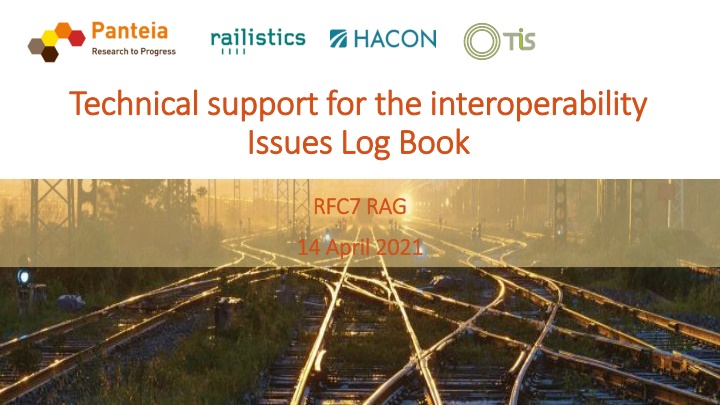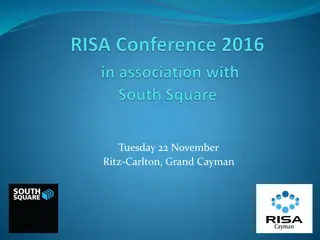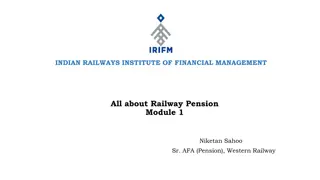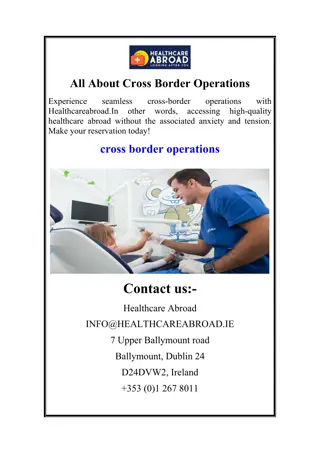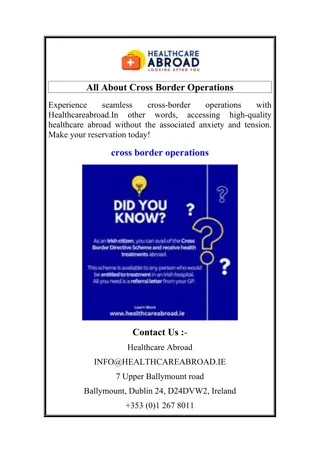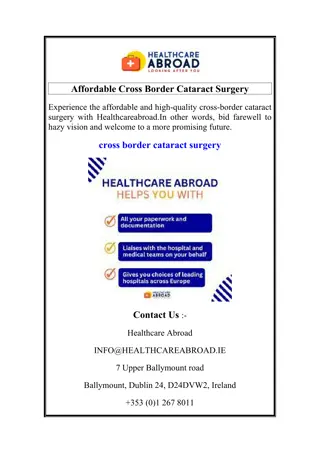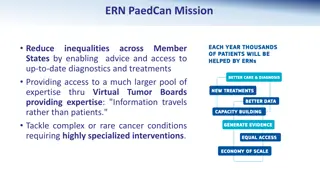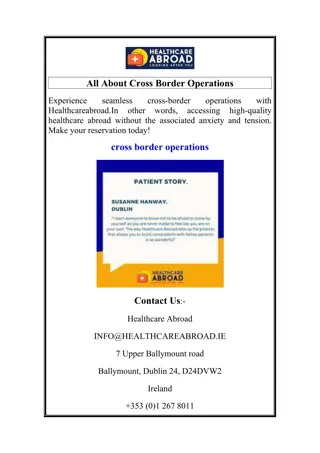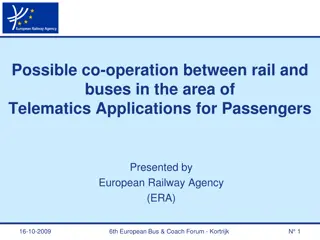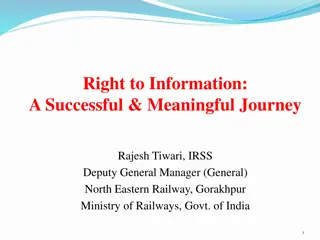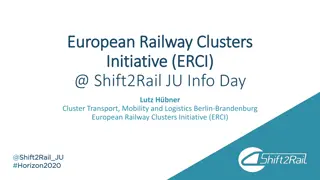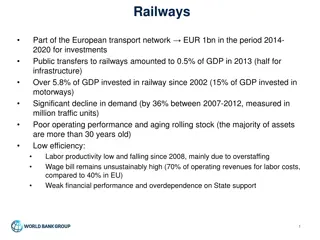Cross-Border Railway Interoperability Challenges: Handbrake Requirements
This document discusses the challenges faced in cross-border railway operations due to differing handbrake requirements, focusing on the need for the last wagon of international trains to be equipped with a handbrake as per national regulations. Issues at border stations in Romania, Hungary, and Bulgaria are highlighted, along with the impact on time and costs incurred due to shunting activities. Stakeholder feedback and proposed solutions are also presented.
Download Presentation

Please find below an Image/Link to download the presentation.
The content on the website is provided AS IS for your information and personal use only. It may not be sold, licensed, or shared on other websites without obtaining consent from the author.If you encounter any issues during the download, it is possible that the publisher has removed the file from their server.
You are allowed to download the files provided on this website for personal or commercial use, subject to the condition that they are used lawfully. All files are the property of their respective owners.
The content on the website is provided AS IS for your information and personal use only. It may not be sold, licensed, or shared on other websites without obtaining consent from the author.
E N D
Presentation Transcript
Technical support for the interoperability Technical support for the interoperability Issues Log Book Issues Log Book RFC7 RAG RFC7 RAG 14 April 2021 14 April 2021
No Issue Title Prio Main tasks 1 Braking sheets 1 - Administrative support - Technical assistance on demand - Progress monitoring 2 Braking performance 1 3 Study on the results of MSs analysis on the use of reflective plates Tail lights vs. plates 3 Train composition - Harmonisation of wagon list Train Composition - Working handbrake last wagon 4 Progress monitoring (together with Issue 15) 2 - Base analysis of the situation (e.g. what problems are caused by the issue, where does the problem occur, national rules on the RFCs, safety aspects); - Assessment of impacts; - Proposal of solutions, incl. identification of solutions already implemented in other countries. - Analysis on national rules for buffer wagons in other European countries; - Elaborate specific TOs together with ERA. 5 2 6 Train Composition - No push 6 axles wagons 2 7 Train Composition - Buffer wagons 2 8 Progress monitoring Technical checks at border stations 2 9 Progress monitoring Mandatory checks in MSs 2 Operational implementation of the traffic in ERTMS 10 - - - Base analysis of the situation (e.g. what problems are caused by the issue, where does the problem occur, national rules on the RFCs, safety aspects); - Assessment of impacts; - Proposal of solutions, incl. identification of solutions already implemented in other countries. 11 New train number - 13 2 people cabin crew - 12 - Exception from operational rules - - Base analysis of the situation (e.g. what problems are caused by the issue, where does the problem occur) by analysis of infrastructure data (e.g. TENtec, Network Statements) and reports (e.g. TEN-T and RFC studies) - Assessment of impacts. Equipment of border stations with commutable electric power supply 14 - Real time communication and harmonisation of train composition message (wagon list) 15 Progress monitoring (together with Issue 4) 2
Issue 5 Issue 5 Working handbrake last wagon Working handbrake last wagon In general, all trains have air pressure brakes that are used during train running; To prevent parking trains from moving, there are different technical possibilities, e.g. handbrakes (parking brakes) or brake shoes; The specific conditions for securing a parking wagon train are specified in the respective national regulations; This specific issue concerns the equipment of wagons and particularly the requirement that the last wagon of a train has to be equipped with a handbrake; In case that the last wagon of an international train entering a country or network with such regulation is not equipped with a handbrake, this requirement might lead to unnecessary shunting at border stations.
Issue 5 Issue 5 Working handbrake last wagon Working handbrake last wagon Stakeholder survey: RO, IT, PT. Follow-up research: Interviews with Xrail, Railcargo, DB Cargo, TX Italy, RTC, RFC7 OEM, RFC9 RHD RO: o According to national regulations, all trains in Romania must have an active handbrake at the last wagon; o The problem specifically arises at the HU/RO border (Curtici) and at the BG/RO border (Ruse): many international trains arriving at these stations do not have the last wagon equipped with a handbrake; this means that shunting is required to position a wagon with a handbrake to the end of the train; o This causes additional time and costs (some operators have to engage external shunting providers); o Since 2016, railway operators tried to solve the issue with the national authorities without success. IT: o In Italy, it is NOT mandatory to have a working handbrake at the last wagon; o Storage of brake shoes on the locomotive (18 brake shoes) and transfer of brake shoes from one locomotive to another locomotive (in case of traction change) is a challenge which is manageable. PT: situation to be clarified; further interviews to be performed
Issue 5 Issue 5 solutions solutions Cleaning up of National Rules referring to requirement of working handbrakes in freight trains , joint activity of COMMISSION DG MOVE and ERA Risk assessment by Railway Undertaking, based on pilot test operations (involving the usage of brake shoes) accompanies elimination of national rule. RUs shall be in charge choosing the best way in securing a parking train, considering common technical standards. Available best practices, such as UIC IRS/leaflets, shall be considered to harmonise both the requirements regarding number and position of handbrakes as well as number, type and position of brake shoes.
Issue 6 Issue 6 No push 6 No push 6- -axle wagons axle wagons Issue only for Romania 6-axle wagons cannot be used in a train with pushing locomotive, despite manufacturer's specifications, conditioned by the infrastructure (steep gradients in the mountains or on bridges) The rule is complicated as it includes train length, train weight and the distribution of weight within the train. Basically, last 300 tonnes gross weight of a train must be without 6-axle wagons For each train, the re-positioning of the wagons has to be calculated individually. Consequences: unnecessary shunting, additional costs, time loss and dead weight, decreases the competitiveness of rail freight transportation (esp. for intermodal trains) National rule
Issue 6 Issue 6 No push 6 No push 6- -axle wagons axle wagons Stakeholder survey: RO Follow-up research: Interviews with Railcargo, DB Cargo, RFC7 OEM, RFC9 RHD o Most common solutions are to split the train in two parts or to add additional traction locomotive. o Rule applies for 6-axle wagons that are located at the end of the train (last 300 tonnes gross weight of the train must be without 6-axle wagons). o Reason for the rule have been accidents in the past, exact date and circumstances of these accidents are not known. o Issue occurs only in intermodal trains (high share of 6-axle wagons up to 100%) and on lines with high gradients requiring a pushing locomotive. o In single wagon traffic problem is prevented by train composition rules (low share of 6-axle wagons in single wagon traffic, 6-axle wagons can be easily placed outside the critical part of the train). o Important lines/areas affected: Predeal-Brasov, Danube bridges, Drobeta Tr. Severin - Balota Vintu de Jos-Coslariu
Issue 6 Issue 6 solutions solutions No evidence found for a general risk of pushing 6-axle wagons. Risk analysis should be performed by the Infrastructure Managers. If risks are identified, access conditions of those lines only should be modified. The national rule of considering 6-axle wagons as exceptional transport is most likely not necessary and should be removed. Rail infrastructure is going to be improved (6 CEF funded projects). Infrastructure updates must be accompanied by a change of operational rules.
Issue 7 Issue 7 Buffer wagons Buffer wagons Number of buffer wagons required between the locomotive and wagons carrying dangerous goods is different in certain Member States. Unnecessary shunting, additional costs, time loss and dead weight. Buffer wagons that are not needed have to be parked, unnecessarily using infrastructure capacity and increasing costs. Buffer wagons may lead to exceeding the permissible train limit values (length, gross weight). The only mandatory rule is found in RID par. 7.5.3: (a) at least 18 m, or (b) occupied by two 2-axle wagons or a wagon with 4 or more axles.
Issue 7 Issue 7 Buffer wagons Buffer wagons BG, HU, RO, DE, as well as RS. Especially Ruse, Curtici, Dimitrovgrad Follow-up research: o HU has cleaned up national rules since 08/2020 positive experiences o BG requires only 1 buffer wagon o RO requires minimum of 12 axles (= 2-6 wagons) o RO requires no buffer wagons for complete petrol trains o RS requires no buffer wagons for petrol trains
Issue 7 Issue 7 solutions solutions TSI-OPE Appendix I lists the areas where national rules are allowed, will apply as from June 2021. (ERA analysis on cleaning-up of national rules) Member States should clean-up national rules in the process of implementing the Fourth Railway Package. Train composition is not an area for national rules. Therefore, national rules in excess of the RID should be cleaned-up as per the railway safety directive that defines the migration strategy from a rule based approach to a risk based one. Commission has adopted an implementing act requesting Romania and Bulgaria to remove the national rule on buffer wagons, pertaining to issue 7 in RO and BG.
Issue 11 Issue 11 New train number New train number Cases where there is no change in the train composition, but IM assigns a new number to the train, which is then considered as a new train, Thus, all train preparation procedures (such as full technical wagon check and brake test) have to be performed again. Stakeholder survey: o All FR/ES borders: Ir n/Hendaye (RFC4), Portbou/Cerb re (RFC6), Perpignan (RFC6) o PT, HU, RO, IT
Issue 11 Issue 11 New train number New train number Follow-up research: Interviews with Xrail, Railcargo, DB Cargo, TX Italy, RTC, RFC7 OEM, RFC9 RHD,.. Issue occurs in HU, (RO) when international train number to national train number at border station e.g. in case of delays: o RO: Some 80% of trains entering RO from HU are affected (Curtici); as the trains have waiting times at the border station anyway due to traction change (Electric Diesel) this is not a major problem. o HU: according to M V rule book, train preparation needs to be done again, braking check and all operational issues are required; Follow-up inquires: RFC7 compiling brief overview; additional info from Traffic Mgt working group leader (via RFC7) Issue does not occur in IT and other Western European countries (cp. Xrail members) Change of train numbers is also connected with Issue 4/15 (Matching of trains in RNE TIS)
Issue 11 Issue 11 solutions solutions Reducing train delays at border stations (particularly Curtici/RO) will lead to less re-numbering of trains and less operational train PaPs - even under current regulatory framework. Optimising information exchange (train numbers, ETA) and border handling processes (issue 8). Ensuring consistent train numbers, preventing trains being considered as a new train; see also Issue 15 (matching of trains in RNE TIS) and the related solutions ( Train ID ). Cleaning up related rules (by Infrastructure Managers): Train checks must be performed o Due to safety reasons / operational needs (change of train configuration, potential standing time, ); o Not to pure formal reasons (only change of train number).
Issue 13 Issue 13 2 people cabin crew 2 people cabin crew Number of drivers/size of cabin crew is required to be 2 in some cases and in some Member States. In some cases 2 drivers are required, in other cases 1 driver + 1 additional staff are required. Consequences: greater planning effort, increased cost for HR. Stakeholder survey: BG, RO, IT Survey results o IT: on some line sections 2 people are required on the cabin Second person necessary to perform tasks on the train and for health & safety reasons. In practise, the second person is not necessary most of the time. Not an issue of railway regulation but related to general worker s health & safety regulations.
Issue 13 Issue 13 2 people cabin crew 2 people cabin crew o BG: line locomotives require 2 locomotive drivers, pushing locomotives require only 1 driver. Double traction requires 3 drivers (2 for the first, 1 for the second locomotive). single locomotive operations can be done with only 1 locomotive driver. o RO: 2 train drivers required only in specific cases Rule nr. 005 (amended in 2019) is regulating this issue regarding two agent train operations. If certain requirements on the train control and signalling system are met, a train can be operated by one agent (driver) only. Second person in the cabin does not have to be a train driver but must be able to stop the train and to intervene in case of danger during train operation. However, a second driver is preferred, as this person could assist the driver during other operations.
Issue 13 Issue 13 solutions solutions Regulations were historically required for safe train operations. Safety systems and driver vigilance devices make additional staff in the cab obsolete. With the introduction of ETCS, a Europe-wide solution can be implemented. National rules need to be removed: Perform risk assessments (railway regulators for RU and BG, and health authorities for IT including sector). Exploring additional technological solutions, such as smart watches to monitor drivers heart rates.
Conclusion Conclusion Key results In-depth insight in (almost) all ILB issues and their solutions Fully updated and informative ILB table Economic impact analysis Forthcoming Further technical assistance to initiatives Ongoing updates ILB information Communication / dissemination End result foreseen Solutions achieved / in progress for all ILB issues Support to stakeholders willing to implement such solutions
